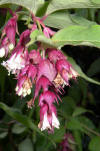 |
 |
 |
 |
 |
| This
lily flower shows the central, 3-lobed stigma, six stamens, three petals and three sepals
(trying their best - and succeeding - to look like extra petals). |
Close up views of the stamens and style of the Lily flower. You can easily see
the pollen grains. |
The
stinging nettle is a wind pollinated plant. If you did not know that these tiny green
bundles were spikes of flowers you would never guess. |
The
white deadnettle may look like a stinging nettle but it is not even in the same family.
These insect pollinated flowers are members of the mint family. When an isect crawls onto
the bottom petal its weight causes the stamens to dip down and dab pollen onto its back! |
| Mike Freedman |
Mike
Freedman |
Mike
Freedman |
| 106Kb |
59Kb |
60Kb |
150Kb |
145Kb |
Return to Flowers, Fruit and Seeds 1 | Return to Flowers, Fruit and Seeds 2
Return to Photo Index |
 |
 |
 |
 |
 |
| Plantains
are common in lawns and fields. The little heads of wind pollinated flowers poke out their
stamens so that the pollen can more easily be blown away. |
A
freshly opened Poppy flower showing the many black stamens and the stigmata arranged
like spokes on a wheel |
After
flowering, fruit begin to develop. This photo shows immature redcurrants. |
Female
willow catkins. Each catkin is a bunch of flowers. Each one has its stigma hanging out to
catch any wind-borne pollen. |
A head of purple
sprouting broccoli |
| Mike
Freedman |
Mike
Freedman |
Mike
Freedman |
Mike
Freedman |
Mike Freedman |
| 183Kb |
169Kb |
174Kb |
40Kb |
106Kb |
|
 |
 |
 |
 |
 |
|
Many flowers are pollinated by insects.
This bumble bee, feeding on a lavender flower, has grains of pollen
stuck to its fur. |
A daffodil flower opening...
Two copies of this photo at different sizes. |
... and the fully opened flower.
Two copies of this photo at different sizes. |
|
Mike Freedman |
|
158Kb |
164Kb
(1024 pixels wide) |
52Kb
(700 pixels wide) |
162Kb
(1024 pixels wide) |
50Kb
(700 pixels wide) |
|
|
 |
 |
 |
 |
|
|
Plants will grow wherever they can. This
snowdrop growing through a crack between paving slabs. The greyish
patches on the slabs are lichen, a primitive plant that is a
combination of alga and fungus. Although they are very primitive
lichens are very important as first colonisers of barren areas,
breaking down the surfaces of rocks with their roots, and as
indicators of air quality. |
Tradescantia, named after John
Tradescant, the Elder (1570s to 1638), gardener to the Earl of
Salisbury at Hatfield and later to the Duke of Buckingham. He and
his son, also John, collected plants from around the known world. |
Himalayan Honeysuckle is a large
spreading herbaceous plant growing up to 2 metres high.
The white flowers grow in hanging bunches. Each flower is protected
by special brightly coloured leaves known as bracts. |
|
|
Lynn Mortlock |
Mike Freedman |
|
337Kb
(1280 x 960 pixels) |
179Kb
(800 x 600 pixels) |
513Kb
(1024 x 677 pixels) |
743Kb
(800 x 1200 pixels) |
|